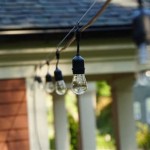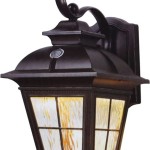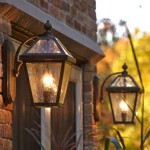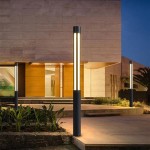The Enduring Appeal of Copper Outdoor Lighting
Copper outdoor lighting has enjoyed consistent popularity for decades, prized for its beauty, durability, and distinct aesthetic qualities. Beyond purely functional illumination, copper fixtures offer a unique blend of rustic charm and sophisticated elegance, enhancing the curb appeal of residences and adding character to commercial landscapes. This article explores the key features and benefits of copper outdoor lighting, detailing its material advantages, design versatility, and maintenance requirements.
The Material Advantages of Copper
Copper is a naturally occurring metal renowned for its excellent conductivity, malleability, and resistance to corrosion. These properties make it an ideal material for outdoor lighting fixtures. Unlike iron or steel, copper does not rust when exposed to moisture and oxygen. Instead, it develops a protective layer called patina, a green or brownish film that forms over time, shielding the underlying metal from further degradation. This patina not only safeguards the copper but also adds a distinctive visual appeal, enhancing the fixture's aesthetic character.
The natural corrosion resistance of copper minimizes the need for frequent replacements, making it a cost-effective choice in the long run. While the initial investment may be higher than that of fixtures made from less expensive materials like aluminum or plastic, the longevity and durability of copper outweigh the upfront cost. Copper fixtures are also less susceptible to damage from extreme weather conditions, including heavy rain, snow, and strong winds.
Furthermore, copper is a recyclable material. At the end of its lifespan, a copper lighting fixture can be melted down and reused without significant loss of quality. This makes copper an environmentally conscious choice for consumers seeking sustainable lighting solutions. The recyclability of copper reduces the demand for newly mined metal, minimizing the environmental impact associated with resource extraction and processing.
Beyond its resistance to corrosion, copper possesses inherent antimicrobial properties. Studies have shown that copper surfaces can inhibit the growth of bacteria and other microorganisms. While this property may not be a primary consideration for outdoor lighting applications, it contributes to the overall hygiene and safety of the environment.
The malleability of copper allows for intricate designs and detailed craftsmanship. Manufacturers can easily shape and mold copper into a variety of forms, creating visually appealing lighting fixtures that complement diverse architectural styles. This versatility in design is a significant advantage, enabling homeowners and designers to choose copper lighting that perfectly aligns with their aesthetic preferences.
Design Versatility and Aesthetic Variety
Copper outdoor lighting is available in a wide range of styles, sizes, and designs to suit various architectural preferences and landscaping needs. From traditional lanterns and sconces to contemporary spotlights and path lights, copper fixtures can be incorporated into virtually any outdoor setting. The warm, reddish-brown hue of polished copper complements natural materials like wood, stone, and brick, creating a cohesive and inviting outdoor space.
One popular style is the traditional lantern, which features a classic design reminiscent of historical gas lamps. These lanterns often incorporate intricate details, such as scrollwork, decorative panels, and clear or frosted glass. Copper lanterns can be mounted on posts, walls, or hung from eaves, providing ambient lighting for walkways, patios, and entryways.
Copper sconces are another versatile option, offering a more subtle and refined aesthetic. These fixtures are typically mounted on walls, providing directional lighting that highlights architectural features or illuminates specific areas. Copper sconces are available in various shapes and sizes, from sleek and minimalist designs to more ornate and decorative styles.
For ground-level illumination, copper path lights are an excellent choice. These fixtures are designed to be placed along walkways, driveways, and garden paths, providing safe and attractive lighting for nighttime navigation. Copper path lights are often equipped with directional shades that focus the light downwards, minimizing glare and maximizing visibility.
Spotlights made of copper are useful for accentuating specific elements of the landscape, such as trees, shrubs, or architectural details. These fixtures can be strategically positioned to highlight the texture and form of plants or to draw attention to particular features of a building's façade. Copper spotlights can be ground-mounted or attached to trees or walls, providing flexible lighting options for various landscaping applications.
The aesthetic appeal of copper lighting is further enhanced by its ability to develop a patina over time. This natural aging process gives each fixture a unique character and a sense of history. The patina can range in color from a light green to a deep brown, depending on the environmental conditions and the composition of the copper alloy. Some homeowners prefer the natural patina, while others opt to preserve the original polished copper finish through regular cleaning and maintenance.
The flexibility of copper as a material also allows manufacturers to integrate different types of light sources, including incandescent, halogen, LED, and solar technologies. This versatility enables homeowners to choose the most energy-efficient and cost-effective lighting options for their specific needs. LED lighting has become increasingly popular due to its long lifespan and low energy consumption, making it an ideal choice for outdoor applications.
Maintenance and Longevity of Copper Fixtures
While copper is a durable and low-maintenance material, some routine care is necessary to preserve its appearance and ensure optimal performance. The frequency and type of maintenance required depend on several factors, including the environment, the type of finish, and the desired aesthetic.
One of the primary considerations is the patina. As mentioned earlier, copper develops a natural patina over time, which can be either embraced or prevented. If the goal is to maintain the original polished copper finish, regular cleaning is essential. This can be accomplished using a mild soap and water solution, followed by a thorough rinsing and drying. A copper polish can also be applied to restore the shine and protect the metal from oxidation.
If the patina is desired, minimal maintenance is required. In some cases, the patina may develop unevenly, resulting in a mottled or patchy appearance. To promote a more uniform patina, the fixture can be exposed to a solution of ammonia and salt water. This accelerates the oxidation process, creating a consistent and attractive patina across the entire surface.
Regardless of the finish, it is important to inspect copper outdoor lighting fixtures periodically for any signs of damage or wear. Check for loose screws, cracked glass, or damaged wiring. These issues should be addressed promptly to prevent further deterioration and ensure safe operation. Loose screws can be tightened, and cracked glass should be replaced. Damaged wiring should be repaired or replaced by a qualified electrician.
The bulbs within the copper fixtures should also be checked regularly and replaced as needed. When selecting replacement bulbs, consider the energy efficiency, light output, and color temperature. LED bulbs are a popular choice due to their long lifespan and low energy consumption, but other options may be more suitable depending on the specific application and aesthetic preferences.
In coastal areas or environments with high levels of air pollution, copper fixtures may be more susceptible to corrosion and discoloration. In these environments, it is particularly important to clean the fixtures regularly and apply a protective coating to prevent damage. Special coatings designed for copper can help to shield the metal from the elements and maintain its appearance for longer periods.
Proper installation is also crucial for the longevity of copper outdoor lighting. Ensure that the fixtures are securely mounted and properly grounded to prevent electrical hazards. Follow the manufacturer's instructions carefully when installing the fixtures, and consult with a qualified electrician if necessary.
Finally, consider the placement of copper outdoor lighting fixtures. Avoid placing them in areas where they are likely to be exposed to excessive moisture, chemicals, or physical damage. Strategic placement can help to prolong the life of the fixtures and enhance their overall performance.

Copper Outdoor Lighting Bevolo

Copper Exterior Lighting

Copper Outdoor Wall Lantern Old Lighting By Exterior Series Spring Street 1020 8 Cc

Copper Exterior Lighting

Acclaim Lighting Manchester Collection 1 Light Copper Patina Outdoor Wall Lantern Sconce 8413cp The Home Depot

Set Of 2 15 Battery Motion Sensor Copper Outdoor Wall Light 64r85 Lamps Plus

Copper Exterior Lighting

Max Spread Copper Path Light Volt Lighting

Outdoor Porch Lights Custom Copper Entryway Lighting

Brass And Copper Exterior Wall Light Traditional Vintage Lighting Collective
Related Posts







